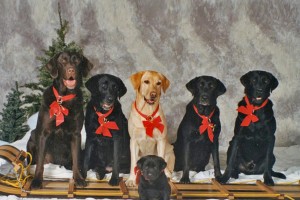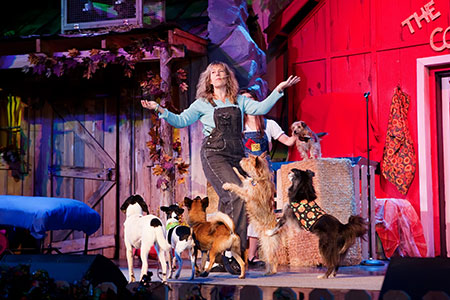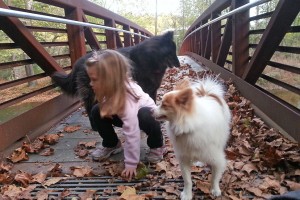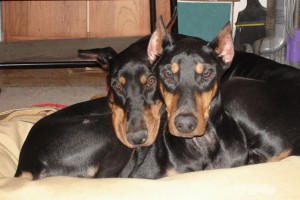Angels Among Us: Remembering My Sweet Angel Kera
The approaching anniversary of one year since I lost Kera is not a happy anniversary but we will approach it as we did with Merlin’s anniversary loss; by remembering the love and laughter that Kera brought to our lives. So with that in mind, I will honor Kera here as I did with Merlin, by honoring her life. I hope I can do her spirit justice.
To my sweet angel puppy: I called you that name, one of many nicknames, for your entire life because you not only looked like an angel, with your pure white coat but you acted like an angel as well.
The day that I first saw you, with Merlin in tow, was arriving at the shelter to pick up an overnight guest as a possible playmate for my baby boy Merlin. You were coming out of the back door with a dog walker, who happened to be a friend and you and Merlin immediately connected. I was told that was the first sign of engagement you had shown since you arrived at the shelter from a hoarding situation at just about three months of age. Our overnighter failed so I asked about adopting you instead. I was heartbroken to be told that I was third in line. Your beauty had a waiting list! I prayed and prayed that I would be chosen and the prayers were answered by those before me on the list, failing to follow through. Merlin and I rejoiced!
We brought you home full of joy, though Merlin was a bit rude initially, after he realized he would have to share his mom. But he was clearly smitten by you first and foremost, as was I and he quickly became your partner in crime, trashing anything that fell into the path of tandem puppies at play!
I felt like I had found my yin and yang, with my black puppy and my white puppy. Out world was sweet and special.
You were initially not thrilled when we started fostering Dobermans, after Ladybug, our first foster girl, tried hanging her head over your back as a greeting gesture! But you made your position as princess clear, without bloodshed, maintaining your regal stature that you presented so appropriately.
Then came a handful of puppies to foster and you avoided them deftly while your partner in crime reveled in their attention, without slightly you in the affection department. But as days went, you seemed to choose a puppy to bestow your grace on and the decision to keep Siri became clear. She was the first and only puppy that you ever showed an interest in.
Fast forward when Trent came as an emergency foster pup, just thirteen months old, with a sad history that spanned seven of those months. You welcomed him with open paws and taught him how to play. It was a joy to watch you chase him and him you and the way that he admired you.
Then came Damon and you were so gentle with his needs. You never asked more than he could give.
You charmed the Therapy Dog testers into urging me to certify you. Charm came so easily to you, making even a grumpy dog hater smile at how beautiful you were with such a happy grin you wore so often. You wore your yellow therapy dog tag so proudly and brought smiles to the faces of mom’s nursing home staff at the time.
You had such sweet traits that made us laugh and smile. The joy you viewed meals with was contagious. Asking you if you wanted to eat would result in the cutest dance from you, with a huge grin on your face. You spent your days smiling and making my life so much better for seeing that smile.
You took such good care of Siri and Trent, trusting Merlin to take good care of you. You were tolerant with Trent’s grooming you and Siri watching nervously over you as you started aging too much for us to ignore.
You were patient with my distress when Merlin was ill and fighting cancer. My distress was so great, that I failed to notice your increasing signs of doggy dementia right away. You were even more patient with the medical tests to diagnose your kidney issues. The ultimate test of your patience and love was your tolerance with my lack of skills and sheer terror of administering subcutaneous fluids. It was only my knowledge of how much better they made you feel that helped me forge ahead and learn to feel comfortable to make you more comfortable.
I made mistakes during my attempts to keep you around as long as possible and I can only hope that they did not cause you too much distress. I tried to do all the right things. I finally had to face that it was perhaps time to allow you to rejoin Merlin.
It was one of the hardest days of my life. You made it easier by allowing me to find the single red rose (from Merlin?) and the single red carnation (from you?) in the oddest spot possible when walking Siri and Trent the day after saying goodbye to you on this earth. I still have them and I cherish them always. I love you Kera, my munchkinland, my pretty princess, my angel puppy, my pumpkin pie, my Miss-Kera-who’s-pretty, I will love you forever. Thank you for being such a part of my life and I look forward to the day that our paths cross again. Until then, I carry your memory in my heart and celebrate your life with us.
Posted in: Projects
Leave a Comment (2) →













